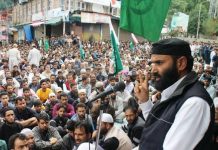Shooting still and moving pictures for the first time, Veer Munshi’s tripartite work Shrapnel sends a seeking shout into the emptied vales of Kashmir, says Aradhna Wal

IN THE sunlit hallway of the gallery, surrounded by pictures of grand houses in ruins, stands Veer Munshi. He gestures towards the frames, saying, “You understand this is still a work in the making.”
The artist, a Kashmiri Pandit in exile, left Srinagar in 1990, and has been based in Delhi since. “I went back after 17 years to shoot this series, as a personal catharsis. It can get depressing. I was an insider but am now an outsider. I want to go home; instead I have to live in hotels like a tourist,” he says. “But I will never be a tourist.”
Munshi’s career has been a constant negotiation with a displaced identity, and the fractured feelings it begets. In 1990, the then 32-year-old artist left for Delhi, thinking he would soon be back home. In a few days his family followed, and soon after, the entire Kashmiri Pandit community. There was no goodbye. “We were disconnected from Delhi. We didn’t choose to live here. Our mannerisms, our thinking, our lifestyles were all rooted in Kashmir.” Blindsided by the forced exodus, his inward eye turned home. Kashmir became both a backdrop and an actor in his work. Shrapnel, his most recent exhibition, is an attempt to archive his vanishing homestead and the multiplicity of his emotional response to it. The nomenclature is apt, as the show’s three compartmentalised works are contained explosions — forceful, direct with both velocity and vector. They are a collision, almost, of shards of the 57-year-old’s childhood memories of Srinagar and present day reality.
Srinagar-born and Delhi-based Veer Munshi is an artist in exile. His painting Terrorist on a Floating Land (1991) marks the beginning of his engagement with the losses faced by Kashmiris. Munshi got his Bachelor of Fine Arts from the University of Baroda. His latest show Shrapnel, curated by Ranjit Hoskote, has already exhibited in Kolkata, Delhi and Mumbai and is slated to go on show in Srinagar and Bengaluru.
The three sections of the show are a video installation, Hands like Leaves of Flame, a series of photographs, Pandit Houses, and a graffiti installation The Chamber. The violence of displacement and the longing for home are palpable through the surface calm of the man and the art.

In the video one follows Munshi trekking through rubble and knee deep snow in Srinagar, from spring to winter, as a huge manor burns simultaneously on the adjacent screen. The camerawork is shaky and basic, yet there is a sense of impending frenzy as Munshi hunts for the home that was. However, in the darkened room, it is the burning building, a rich cultural heritage swallowed up in flames, which draws the eye. The pathos is palpable, and it’s unsurprising to find that Munshi’s own house was burned down and the land it sat upon summarily sold. He doesn’t know the details, though the probable cause of arson was a crossfire between militants and security forces. The video doesn’t need the story, because the story isn’t specific to Munshi.
The photographs are a framed narrative sequel. Abandoned Kashmiri Pandit houses populate Srinagar; stark skeletal reminders of the life that once thrived. This is Munshi’s first time as a photographer. Yet the pictures have a decided impact. The beauty lies in the simplicity — the unembellished shots and clean geometric lines that allow the house to tell its own story. “I could have painted them,” he says. “But then they would bear my stamp. These houses have so many things to say. Photography, more than painting, allows them to do so.”
It took him three years to learn the process and technicalities. “As it is with painting, I kept doing it over and over again, till that magic came and a picture became a work of art.” He animates the stills with stories of yore, describing how two different houses would be built connected by bridges that would be thrown open during festivals and celebrations, be they Muslim or Hindu. “This one is my aunt’s house. It had a huge upper storey where we would play cricket during the frozen winters. My sister’s wedding reception was held there. It had a beautiful khatumbandh, a ceiling made from weaving together wood. The other, Professor TN Madan’s, whose family I knew. You see this one right here? I can picture the family sitting out in the jharokha, looking down at the people on the roads, having their morning tea, an important ritual in most households.”
The series came together like a puzzle. Munshi would look for fellow exiles, track them down, hear their story and then capture the house. The people behind the pictures were as important as the image on the wall. “An old friend, Muzzafar, who passed away sometime ago, helped me find these houses. My own memory had faded.”
These photographs are the show’s thematic lynchpin. The houses were at the core of the Srinagar that was; their very bones built for the land, the snow and the rocky terrain. Even today they stand out amongst the superimposed cluster of buildings that are replacing them. Munshi’s anxiety goes beyond preserving his personal memories, to archiving an architectural history of Kashmir, not as a sentimental salvage but as a living document. He calls it activism through art; to get the houses declared heritage sites.
Says Munshi, “Any society needs a composite culture. The people in Kashmir today are bereft. The Pandit no longer knows the Muslim and the Muslim no longer knows the Pandit.” Conservation is a pressing concern. “Often, a people’s local identity is tied to a place’s architecture,” confirms Divay Gupta, Principal Director of INTACH’s Architectural Heritage Division. “These sites have no legal sanctity, leaving them vulnerable. We call them unprotected heritages.” One photograph shows the Lal Ded Memorial School before a private builder razed it for a glass and steel shopping complex. A quiet, slow heart-ache assumes a pounding urgency with the knowledge of how fast the decay is.
It doesn’t take a telescopic lens to detect Munshi’s struggle to accept the way the world is. He started out with anger and morbidity on canvas. Over the years, that has dissipated. Instead his energy has turned to hunting for reason. Why the violence, and how does one deal with displacement? “I am not a political spokesperson for Kashmiri Pandits. Being part of one minority I understand the concerns of the minorities everywhere; be it a Kashmiri Pandit here, or a Muslim in Gujarat or a Sikh elsewhere. It is easy to hate, to be reactionary because of the violence. But I have to rise above the bitterness and look for solutions.”
With the help of an old friend Munshi tracked down exiled Kashmiris, heard their stories and then captured their houses
The violence is addressed directly in the final chapter, The Chamber. The concept has the fascinating simplicity of a bullet or a bomb. Put a person inside a room where only the four walls covered in graffiti-esque art are visible. The viewer is trapped inside, with no way to escape the sharp metal objects and screaming figures. A literal explosion with flying shrapnel and an allegory for the disruptive, destructive qualities of bits, bytes and bullets of unending information. It is that split second of disbelief, denial, indecision induced by terror, unprocessed and starkly familiar.
However, the determined calm that Munshi has employed in the rest of the show proves an obstacle. Here, where he should have really let go and created as much tumult as possible, he seems a tad reserved. Was that a gunshot or a backfire? The bang is not as loud as it could be, and the explosions seem contained.
The form is experimental, but perhaps not the tilt-shift that changes a view of the world. Munshi has stuck to his politics. Says art critic Ina Puri, “The change is really in the form of diminished hope from his earlier shows. There is no happier tomorrow, but an effort to accept the brutal present. Kashmir is heartbreakingly beautiful, but a peopleless land. There are no children on the street.” There is no one in Munshi’s pictures either.
Aradhna Wal is a Sub-Editor with Tehelka.
aradhna@tehelka.com













